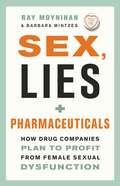- Table View
- List View
Sex Surveyed, 1949-1994: From Mass-Observation's "Little Kinsey" To The National Survey And The Hite Reports
by Liz StanleyFirst Published in 1995. Routledge is an imprint of Taylor & Francis, an informa company.
Sex Work, Health, and Human Rights: Global Inequities, Challenges, and Opportunities for Action
by Shira M. Goldenberg Ruth Morgan Thomas Anna Forbes Stefan BaralThis open access book provides a comprehensive overview of the health inequities and human rights issues faced by sex workers globally across diverse contexts, and outlines evidence-based strategies and best practices. Sex workers face severe health and social inequities, largely as the result of structural factors including punitive and criminalized legal environments, stigma, and social and economic exclusion and marginalization. Although previous work has largely emphasized an elevated burden and gaps in HIV and sexually transmitted infection (STI) services in sex work, less attention has been paid to the broader health and human rights concerns faced by sex workers. This contributed volume addresses this gap. The chapters feature a variety of perspectives including academic, community, implementing partners, and government to synthesize research evidence as well as lessons learned from local-level experiences across different regions, and are organized under three parts:Burden of health and human rights inequities faced by sex workers globally, including infectious diseases (e.g., HIV, STIs), violence, sexual and reproductive health, and drug use Structural determinants of health and human rights, including legislation, law enforcement, community engagement, intersectoral collaboration, stigma, barriers to health access, im/migration issues, and occupational safety and healthEvidence-based services and best practices at various levels ranging from individual and community to policy-level interventions to identify best practices and avenues for future research and interventionsSex Work, Health, and Human Rights is an essential resource for researchers, policy-makers, governments, implementing partners, international organizations and community-based organizations involved in research, policies, or programs related to sex work, public health, social justice, gender-based violence, women's health and harm reduction.
Sex and Diabetes
by Joycelyn Elders Janis Roszler Donna RiceSex & Diabetes is the first book ever to deal exclusively with sexual problems as they relate to diabetes- and the only book to discuss issues that relate to both men and women.It also shows you how sexual problems can be prevented or delayed and discusses treatments options that currently exist. Sex & Diabetes highlights the value of communication between sexual partners and the importance of having an open relationship with healthcare professionals.
Sex and Gender Aspects in Clinical Medicine
by Vera Regitz-Zagrosek Sabine Oertelt-PrigioneThis book is a concise, easy to read professional text with a focus on practical aspects. All chapters include tables on sex/gender differences in symptoms and management and a series of suggestions to the novice in the field. Chapters are specialty-specific. The focus is not on women's health, but the presentation of differences in clinical symptoms, management and outcomes in women and men. Gender Medicine strives to employ the knowledge about these differences to improve diagnosis, better understand pathogenesis and advance patient-oriented therapy.
Sex and Gender Differences in Infection and Treatments for Infectious Diseases
by Sabra L. Klein Craig W. RobertsThis book provides an overview of the underlying sex-based and hormone-based differences in immunity, wound healing and pharmacokinetics, while also exploring how pregnancy affects immunity. The second part of the book shows, for the first time in a single volume, the growing number of infectious diseases for which sex and gender differences are noted, identifies common as well as distinct mechanisms mediating these differences and illustrates how responses to treatments might differ between the sexes. The awareness that males and females differ in their response to specific pathogens as well as to treatments for infectious diseases may yield sex-specific personalized treatments. This book will be of interest to basic scientists and clinicians in the fields of microbiology, immunology and pharmacology. Individuals working in academia, government and industry will also benefit from the information presented.
Sex and Gender Differences in Infection and Treatments for Infectious Diseases (Current Topics in Microbiology and Immunology #441)
by Sabra L. Klein Craig W. RobertsThis fully revised and significantly expanded second edition examines sex and gender differences in the immune system's response to bacterial, viral, and parasitic infections. The volume discusses both common and distinct molecular mechanisms that mediate these differences and illustrates how responses to vaccines may differ between the sexes and in pregnant individuals. Special emphasis is placed on the interplay between hormones and the immune system in the pathogenesis of HIV, SARS-CoV-2, influenza, malaria, tuberculosis, and amebiasis. This second edition includes completely rewritten chapters as well as all new contents.This book is intended for researchers in academia and industry as well as clinicians in the fields of microbiology, immunology, and pharmacology. By expanding knowledge in sex and gender medicine as a basis for developing personalized treatment strategies, the book contributes to UN Sustainable Development Goals 3 (health and well-being) and 5 (gender equality).
Sex and Gender Differences in Pharmacology
by Vera Regitz-ZagrosekThis is the very first book to deal with sex and gender differences in drug therapy - an increasingly recognized medical need. It starts with an overview on S/G in clinical syndromes and a documentation of the medical and socioeconomic damage caused by gender specific adverse drug effects. Part I covers S/G differences in pharmacokinetics. Researchers will be satisfied by the detailed discussion of the mechanisms of S/G differences in drug effects that represents cutting edge science and includes interaction of drugs with sex hormones, genomic and epigenetic mechanisms. It also covers S/G in drug development, in animal models and clinical development and S/G in drug prescriptions. Part II targets S/G differences in drug effects in cardiovascular, pulmonary, CNS, neuromuscular, neuropsychiatric and metabolic diseases, in cancer, inflammation, and rheumatic diseases, in bacterial and retroviral infections, thrombosis, embolism. New drugs will be discussed.
Sex and Gender Effects in Pharmacology (Handbook of Experimental Pharmacology #282)
by Stella E. Tsirka Maricedes Acosta-MartinezBiological sex and gender have a tremendous impact on the efficacy and safety of pharmacological interventions in virtually every disease state. This book presents a comprehensive and up-to-date overview on how sex-specific information is guiding the diagnosis and treatment of diseases affecting men and women, as well as of disease states that disproportionally affects women. Experts in various fields discuss both preclinical and clinical research that is contributing to a better understanding of the impact of sex in the presentation, etiology, treatment, and disease outcomes. Also discussed are the challenges encountered in implementing this growing body of knowledge into practice, as well as possible avenues to recognize and reduce health disparities between men and women so that therapeutic interventions are tailored and improved.
Sex and Gender Factors Affecting Metabolic Homeostasis, Diabetes and Obesity (Advances In Experimental Medicine And Biology #1043)
by Franck Mauvais-JarvisThe book provides a reference for years to come, written by world-renowned expert investigators studying sex differences, the role of sex hormones, the systems biology of sex, and the genetic contribution of sex chromosomes to metabolic homeostasis and diseases. In this volume, leaders of the pharmaceutical industry present their views on sex-specific drug discovery. Many of the authors presented at the Keystone Symposium on "Sex and gender factors affecting metabolic homeostasis, diabetes and obesity" to be held in March 2017 in Lake Tahoe, CA. This book will generate new knowledge and ideas on the importance of gender biology and medicine from a molecular standpoint to the population level and to provide the methods to study them. It is intended to be a catalyst leading to gender-specific treatments of metabolic diseases. There are fundamental aspects of metabolic homeostasis that are regulated differently in males and females, and influence both the development of diabetes and obesity and the response to pharmacological intervention. Still, most preclinical researchers avoid studying female rodents due to the added complexity of research plans. The consequence is a generation of data that risks being relevant to only half of the population. This is a timely moment to publish a book on sex differences in diseases as NIH leadership has asked scientists to consider sex as a biological variable in preclinical research, to ensure that women get the same benefit of medical research as men.
Sex and Gender in Acute Care Medicine
by McGregor, Alyson J. and Choo, Esther K. and Becker, Bruce M. Alyson J. Mcgregor Esther K. Choo Bruce M. BeckerUntil the past decade, clinicians and researchers assumed that the medical evaluation and treatment of both women and men were the same. This archaic and dangerous notion persisted in spite of the clear anatomic and physiologic differences between the genders. Today, we fully understand that this paradigm is false. In all specialties of medicine, practitioners and researchers are beginning to consider the influence of sex and gender and how it should inform the care of their patients. This book focuses on the issue of sex and gender in the evaluation and treatment of patients specifically in the delivery of acute medical care. It serves as a guide both to clinicians interested in the impact of sex and gender on their practice and to researchers interested in the current state of the art in the field and critical future research directions.
Sex and Pregnancy: From Evidence-Based Medicine to Dr Google
by Dan Farine Pablo Tobías GonzálezPregnant women and their partners often ask healthcare professionals whether sex is safe during pregnancy, and what consequences may result from sexual activity. Many clinicians can also be unsure of the answers to these type of questions, leading to both patient and clinician resorting to the internet for advice, which can be inaccurate and anxiety-inducing. Here, the authors provide clinicians with an insight into the information offered by 'Dr Google' so that they can reassure and advise their patients as necessary. Aimed at obstetricians and other physicians caring for pregnant women, this book reviews the implications of sex during pregnancy such as those complicated by medical conditions, those at risk of preterm birth and multiple pregnancies. Other chapters cover physiological changes during pregnancy that may affect sexual function and intimacy, as well as the differing guidelines provided by various global obstetric societies.
Sex and Sexualities in Contemporary Indonesia: Sexual Politics, Health, Diversity and Representations (Sexuality, Culture and Health)
by Linda Rae Bennett Sharyn Graham DaviesWinner of the 2015 Ruth Benedict Prize for Outstanding Edited Volume Sex, sexuality and sexual relationships are hotly debated in Indonesia, triggering complex and often passionate responses. This innovative volume explores these issues in a variety of ways. It highlights historical and newer forms of sexual diversity, as well as the social responses they provoke. It critiques differing representations of sexuality, pointing to the multiplicity of discourses within which sexuality and ‘the sexual’ are understood in modern-day Indonesia. Placing sexuality centre-stage and locating it within the specific historical context of the Reformasi era, this landmark volume explores understandings and practices across a wide variety of sites, focusing in on a diverse group of Indonesian actors, and the contested meanings that sexuality carries. Beginning with a substantive introduction and concluding with a scholarly reflection on key issues, the volume is framed around the four themes of sexual politics, health, diversity and representations. It seeks both to present new empirical findings as well as to add to existing theoretical analysis. This work fills an important gap in our understanding of the evolution and contemporary dynamics of Indonesian sexualities. It will be of interest to scholars and academics from disciplines including gender and sexuality studies, global health, sexual and reproductive health, anthropology, sociology and Asian studies.
Sex and the Brain
by Gillian EinsteinThis collection of foundational papers on sex differences in the brain traces the development of a much-invoked, fast-growing young field at the intersection of brain and behavior. The reader is introduced to the meaning and nature of sexual dimorphisms, the mechanisms and consequences of steroid hormone action, and the impact of the field on interpretations of sexuality and gender. Building on each other in point-counterpoint fashion, the papers tell a fascinating story of an emerging science working out its core assumptions. Experimental and theoretical papers, woven together by editor's introductions, open a window onto knowledge in the making and a vigorous debate between reductionist and pluralist interpreters. Five major sections include papers on conceptual and methodological background, central nervous system dimorphisms, mechanisms for creating dimorphisms, dimorphisms and cognition, and dimorphisms and identity. Each section builds from basic concepts to early experiments, from experimental models to humans, and from molecules to mind. Papers by such leading scholars as Arthur Arnold, Frank Beach, Anne Fausto-Sterling, Patricia Goldman-Rakic, Doreen Kimura, Simon LeVay, Bruce McEwen, Michael Merzenich, Bertram O'Malley, Geoffrey Raisman, and Dick Swaab, illustrate a rich blend of perspectives, approaches, methods, and findings. Sex and the Brainwill show students how a scientific paper can be analyzed from many perspectives, and supply them with critical tools for judging a rapidly emerging science in a contentious area.
Sex and the Planet: What Opt-In Reproduction Could Do for the Globe (Basic Bioethics)
by Margaret Pabst BattinWhat if human reproduction was always elective? A prominent bioethicist speculates about the possibilities—and the likely consequences.What would the world be like if all pregnancy was intended, not unintended as it is nearly half the time now? Considerably better, Margaret Pabst Battin suggests in Sex and the Planet, a provocative thought experiment with far-reaching real-world implications. Many of the world&’s most vexing and seemingly intractable issues begin with sex—when sperm meets egg, as Battin puts it—abortion, adolescent pregnancy, high-risk pregnancy, sexual violence, population growth and decline. Rethinking reproductive rights and exposing our many mistaken assumptions about sex, Sex and the Planet offers an optimistic picture of how we might solve these problems—by drastically curtailing unintended pregnancies using currently available methods.How we see this picture—as recommendation, prediction, utopian fantasy, totalitarian plot, hypothetical conjecture, or realistic solution—depends to a great degree on which of thirteen problematic assumptions we maintain, assumptions Battin works to identify and challenge. Taking on sensitive topics like abortion and rape and religious issues around contraception, she shows how a fully informed, nonideological approach could defuse much of the friction such issues tend to generate. Also, in her attention to male contraception and the asymmetry of female and male reproductive control, she pulls in the 50 percent of the human race—those with Y chromosomes—largely left out of discussions of reproductive health. Sex and the Planet, finally, takes a global view, inviting us to consider a possible—even plausible—reproductive future.
Sex in Cetaceans: Morphology, Behavior, and the Evolution of Sexual Strategies
by Bernd Würsig Dara N. OrbachSex in Cetaceans provides an up-to-date review of multi-faceted aspects related to mating and reproduction in toothed and baleen whales. This open access book begins with discussions of sexual selection and anatomical traits related to mating and diversity between the sexes. The functions of non-conceptive copulations are reviewed as are different research techniques applied to explore sex in cetaceans. Authors and editors build knowledge of female and male social, mating, and parental strategies and tactics for several specific toothed dolphin/porpoise/whale species and baleen whale species. It concludes with a discussion of potential conservation efforts and ways to help especially beleaguered species and populations the world over. The volume is intended as a major primer of cetacean sex for undergraduate and graduate students, new and established researchers in the field, and the public wishing to learn more.
Sex in the Brain: How Seizures, Strokes, Dementia, Tumors, and Trauma Can Change Your Sex Life
by Amee BairdWhat controls our sex lives? Our brains. Yet there is surprisingly little research into how our brains influence one of the most fundamental of all human behaviors. And there is even less understanding of what can happen to the sexuality of a person who suffers a brain injury or illness such as a stroke, Parkinson’s disease, or dementia.In Sex in the Brain, clinical neuropsychologist Amee Baird explores fascinating case studies of dramatic changes in sexual behavior and explains what these exceptional stories have to say about human sexuality. She illuminates the extraordinary insights into how the brain works that injury or disease can divulge. Each chapter includes striking personal accounts, many from individuals Baird has met in her clinical practice, of unexpected shifts in sexuality. Until now these fascinating, frightening, and funny stories have been hidden in medical journals or untold outside of the clinical setting. This revealing and sometimes heartbreaking book unfolds a better understanding of the links between brain function and our sexual selves.
Sex, Drugs and Young People: International Perspectives (Sexuality, Culture and Health)
by Peter Aggleton Andrew Ball Purnima ManeSexual practices and drug use among the young are examined in this book, calling into question mainstream assumptions about ‘adolescence’. Bringing together a range of cross-cultural and cross-national contributions, the book reveals both similarities and important differences that mark sexuality and drug use among young in different social and cultural settings. In doing so, it allows the reader to build up a clearer understanding of the challenges that must be faced in public health and education if we are to develop programs and interventions that really serve the needs of young people. The book will be of interest to professionals working with young people and is suitable for a wide range of multidisciplinary courses covering areas such as human sexuality, sex education, public health and social work.
Sex, Drugs, and Rock 'n' Roll: The Science of Hedonism and the Hedonism of Science
by Zoe CormierFull of noise and color, Sex, Drugs, and Rock ’n’ Roll looks at scientists and their craft, how hedonistic impulses inform our highest pursuits, and how the renegades of science have illuminated the secrets of our deepest impulses. It is a fascinating tale of scientists on the edge, experimenting on themselves and others, that asks the big (and strange) questions about what it means to be human, about consciousness and happiness, the future and past of our species, our scientific knowledge, and our culture. Not to mention our parties. It will pull you in and gross you out, but it never loses sight of the stories, ideas, and scientific discoveries that make sex, drugs, and rock ’n’ roll so timeless.
Sex, Gay Men and AIDS
by Peter DaviesThis book reports on the largest empirical study of male homosexual behaviour in the UK for thirty years. Important new theories about sexuality are developed, which expose unhelpful stereotypes and challenge outdated assumptions about AIDS.
Sex, Intimacy and Living with Life-Shortening Conditions
by Sarah Earle Maddie BlackburnThis multi-disciplinary and inclusive collection brings together theoretically informed and empirically focused research on sex, intimacy and reproduction in relation to young people and adults with life-shortening conditions. Advances in healthcare mean that increasing numbers of young people with life-shortening conditions are transitioning into adulthood. Issues such as sex and intimacy, dating and relationships, fertility and having children are increasingly relevant to them and to the people that support them, including families, carers, practitioners and professional education, health and social care agencies. This three-part book explores the relevance and significance of this field, examines everyday experiences, and highlights the challenges faced by individuals and organisations in addressing the needs of such people in daily life and in the context of practice. Drawing on perspectives from sociology, disability studies, epidemiology, health policy, psychotherapy, legal studies, queer studies and nursing, this ground-breaking volume is written by academics, policy makers, practitioners and experts by experience. It is an essential read for all those practising and researching in the fields of sexuality, chronic illness and disability and transition.
Sex, Lies, and Pharmaceuticals
by Ray Moynihan Barbara MintzesAgainst a backdrop of virtual intercourse, online porn, and burgeoning Viagra sales, Sex, Lies, and Pharmaceuticals reveals how women's sexual difficulties are being repackaged as symptoms of a new disorder. In this compelling book, award-winning journalist Ray Moynihan teams up with drug assessment specialist Barbara Mintzes to investigate the creation of female sexual dysfunction or FSD, and the marketing machine that promises to "cure" it.The authors go inside the corridors of medical power to visit drug company-sponsored scientific meetings and medical education events where doctors are being trained to see women's sexual problems as the symptoms of FSD - a pharmaceutically treatable condition. Moynihan and Mintzes explore the underlying causes of sexual dissatisfaction among women and expose how global drug companies exploit those problems in an attempt to create the next billion dollar disease.
Sex, Sickness, and Slavery: Illness in the Antebellum South
by Mayzie Hough Marli F. WeinerMarli F. Wiener skillfully integrates the history of medicine with social and intellectual history in this study of how race and sex complicated medical treatment in the antebellum South. Sex, Sickness, and Slavery argues that Southern physicians' scientific training and practice uniquely entitled them to formulate medical justification for the imbalanced racial hierarchies of the period. Challenged with both helping to preserve the slave system (by acknowledging and preserving clear distinctions of race and sex) and enhancing their own authority (with correct medical diagnoses and effective treatment), doctors sought to understand bodies that did not necessarily fit into neat dichotomies or agree with suggested treatments. Focusing on Southern states from Virginia to Alabama, Weiner examines medical and lay perspectives on the body through a range of sources, including medical journals, notes, diaries, daybooks, and letters. These personal and revealing sources show how physicians, medical students, and patients--both free whites and slaves--felt about vulnerability to disease and mental illnesses, how bodily differences between races and sexes were explained, and how emotions, common sense, working conditions, and climate were understood to have an effect on the body. Physicians' authority did not go uncontested, however. Weiner also describes the ways in which laypeople, both black and white, resisted medical authority, clearly refusing to cede explanatory power to doctors without measuring medical views against their own bodily experiences or personal beliefs. Expertly drawing the dynamic tensions during this period in which Southern culture and the demands of slavery often trumped science, Weiner explores how doctors struggled with contradictions as medicine became a key arena for debate over the meanings of male and female, sick and well, black and white, North and South.
Sex, Work and Professionalism: Working in HIV/AIDS (Social Aspects of AIDS)
by Katie DeverellSex, Work and Professionalism examines what happens when professional concern is defined in terms of sex. Based on original fieldwork with outreach workers in HIV prevention it addresses issues of professionalism, emotion work and boundaries, integrating empirical insights with sociological theory. In most professional relationships sex is not defined as part of the relationship, in fact it is explicitly excluded in guidelines and codes of ethics. HIV prevention outreach workers work in sexual environments with a sexually defined target group and are often employed on the basis of their sexuality. They have to learn how to balance their work and professional lives, overcoming conflicts such as: * professional role V community role * sexual skills V sexual boundaries * personal experiences V professional understanding * professional identity V worldviews. Many of the questions being raised in this book about the meaning of professionalism, the pain and pleasure in emotion work and the management of boundaries between home, sex and work are being asked more generally by workers in a range of organisations. Sex, Work and Professionalism argues for a new understanding of professionalism more appropriate to the human services.
Sex- and Gender-Based Analysis in Public Health
by Jacqueline Gahagan Mary K. BrysonThis book is the first to focus on sex- and gender-based analysis (SGBA) in public health, addressing the dearth of thinking, practice, and publication on SGBA and public health. The Canadian government is a global leader in seeking gender equity and mandating SGBA in federal initiatives, programs, and policies, continuing to advocate for the uptake of SGBA. However, there is differential uptake of SGBA in many fields, and public health is lagging behind. This book analyses the movement toward SGBA in Canada and internationally, highlighting some key examples of public health concern such as HIV/AIDS and tobacco use.An international group of experts in the fields of SGBA, public health, program evaluation, policy development, and research comprise the authorship of the book. Collectively, the team of authors and editors have deep expertise in SGBA and public health nationally and internationally and have published widely in the SGBA literature.Topics explored among the chapters – organized under three thematic content areas: the SGBA terrain in public health, illustrative examples from the field, and the implications of SGBA in public health – include:Sex- and Gender-Based Analyses and Advancing Population HealthBeyond “Women’s Cancers”: Sex and Gender in Cancer Health and CareWomen, Alcohol and the Public Health Response – Moving Forward from Avoidance, Inattention and Inaction to Gender-Based DesignUnderstanding Pandemics Through a Sex- and Gender-Based Analysis Plus (SGBA+) LensSex- and Gender-Based Analysis and the Social Determinants of Health: Public Health, Human Rights and Incarcerated YouthGender-Transformative Public Health ApproachesSex- and Gender-Based Analysis in Public Health is an important text for graduate-level students and trainees as well as public health practitioners in a variety of disciplines such as health promotion, nursing, health administration, public administration, sociology, political science, gender and women’s studies. The book also is an essential resource for specialists in public health policy, programming, research, and evaluation.
Sex- and Gender-Based Women's Health: A Practical Guide for Primary Care
by Sarah A. Tilstra Deborah Kwolek Julie L. Mitchell Brigid M. Dolan Michael P. CarsonThis book provides primary care clinicians, researchers, and educators with a guide that helps facilitate comprehensive, evidenced-based healthcare of women and gender diverse populations. Many primary care training programs in the United States lack formalized training in women’s health, or if they do, the allotted time for teaching is sparse. This book addresses this learning gap with a solid framework for any program or individual interested in learning about or teaching women’s health. It can serve as a quick in-the-clinic reference between patients, or be used to steer curricular efforts in medical training programs, particularly tailored to internal medicine, family medicine, gynecology, nursing, and advanced practice provider programs. Organized to cover essential topics in women’s health and gender based care, this text is divided into eight sections: Foundations of Women's Health and Gender Based Medicine, Gynecologic Health and Disease, Breast Health and Disease, Common Medical Conditions, Chronic Pain Disorders, Mental Health and Trauma, Care of Selected Populations (care of female veterans and gender diverse patients), and Obstetric Medicine. Using the Maintenance of Certification (MOC) and American Board of Internal Medicine blueprints for examination development, authors provide evidence-based reviews with several challenge questions and annotated answers at the end of each chapter. The epidemiology, pathophysiology, evaluation, diagnosis, treatment, and prognosis of all disease processes are detailed in each chapter. Learning objectives, summary points, certain exam techniques, clinical pearls, diagrams, and images are added to enhance reader’s engagement and understanding of the material. Written by experts in the field, Sex and Gender-Based Women's Health is designed to guide all providers, regardless of training discipline or seniority, through comprehensive outpatient women’s health and gender diverse care.
























